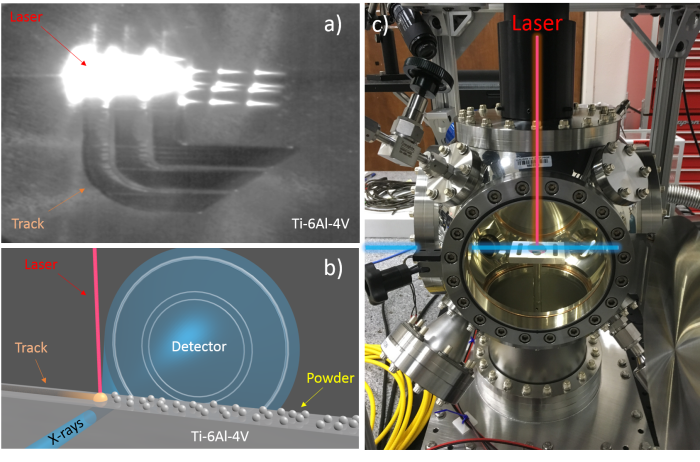Jonathan Lee (17-ERD-042)
Executive Summary
We are investigating a portable experimental apparatus that will enable in situ x-ray diagnostic studies of laser powder-bed fusion additive-manufacturing processes and offers the potential for real-time feedback and process control, dramatically accelerating materials development. Properly configured laboratory x-ray sources can provide process, structure, and property relationships for rapid certification of additively manufactured components in support of the DOE and NNSA goals to maintain the safety, security, and effectiveness of the nation’s nuclear deterrent without nuclear testing.
Project Description
Developing in situ diagnostics of structure and composition during synthesis is a critical component of accelerated materials development because of the feedback they provide to real-time process control. The need for in situ characterization during part manufacture is particularly acute in the field of additive manufacturing, where the means of process control are lagging far behind the rapidly developing additive manufacturing approaches to controlled materials formation. The overarching hypothesis of our research is that properly configured laboratory x-ray sources can provide process, structure, and property relationships for rapid certification of additively manufactured components. These relationships will be illuminated by identifying correlations between additive-manufacturing processes, their consequential growth dynamics, and their resulting structures by direct, in situ measurements of crystal structure, residual stress, solidification kinetics, and defect evolution. Our objective is to accelerate the adoption of additive-manufacturing processes via the development of in situ methods that facilitate informed qualification of additively manufactured components and processes. New bulk-sensitive diagnostics are essential for powder-bed additive manufacturing, where highly non-equilibrium conditions during part manufacture result in residual stresses and defects that degrade mechanical performance. Real-time, in situ structural characterization holds the key to understanding the underlying mechanisms and dynamics to improve build parameters. The x-ray methods of diffraction, small-angle scattering, and radiography that we intend to use in this project will provide new insight into powder-bed processes and identify capability requirements to implement x-ray diagnostics for additively manufactured production.
We will design, build, and commission a narrow-width laser powder-bed additive-manufacturing system for in situ synchrotron studies, and perform initial benchmarking studies using x-ray diagnostics. We will conduct benchmarking studies and time-resolved x-ray diffraction, small-angle scattering, and radiography studies of powder-bed additive manufacturing with experimental beam lines configured to mimic laboratory-based systems. In addition, we will complete a synchrotron-based evaluation of system requirements for conducting in situ structural characterization of powder-bed processes using laboratory sources and detectors. We expect that the initial benchmarking experiments conducted at different DOE synchrotron laboratories will provide unprecedented insight into the mechanisms and dynamics of additive-manufacturing powder-bed processes. The knowledge gained should provide important contributions to the extended scientific community, lead to high-profile publications, and enhance the Lawrence Livermore National Laboratory's capabilities in this active field of research. More importantly, identification of the capabilities required to implement in situ x-ray techniques in a stand-alone laboratory-based system offers the potential for real-time feedback and process control on a day-to-day basis, dramatically accelerating materials development using powder-bed additive manufacturing.
Mission Relevance
This research supports the Laboratory's core competency in advanced materials and manufacturing, particularly the priorities in materials design and manufacturing, and the development of in situ diagnostics. The work also provides a foundational capability for the development of new additively manufactured materials for stockpile stewardship science, which supports the DOE and NNSA goals to maintain the safety, security, and effectiveness of the nation’s nuclear deterrent without nuclear testing.
FY17 Accomplishments and Results
In FY17 we (1) designed a portable experimental apparatus that will enable in situ x-ray diagnostic studies (diffraction, radiography, and scattering) of laser powder-bed fusion additive-manufacturing processes—design elements of our apparatus include the capability to mimic laboratory-based x-ray systems and to achieve measurements over a broad range of temporal resolutions, from sub-microseconds to seconds; (2) identified and placed the orders for the required components to build this device; and (3) identified optimal experimental configurations for operation of the apparatus at different DOE synchrotron laboratories.






